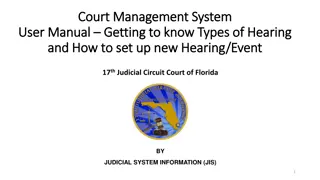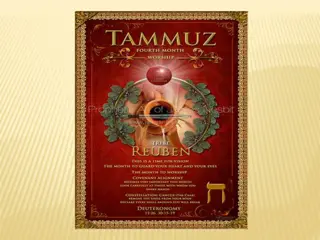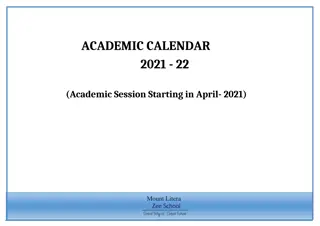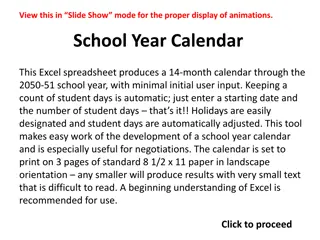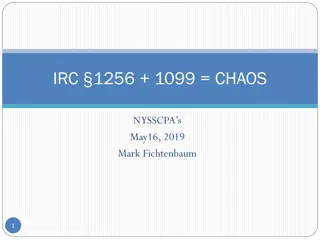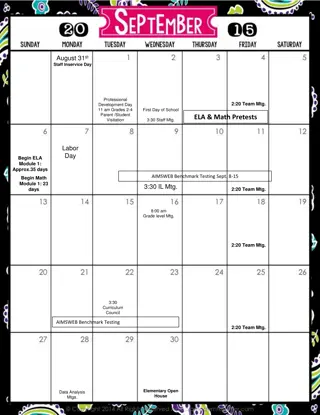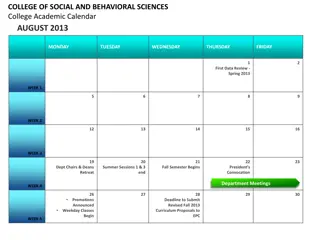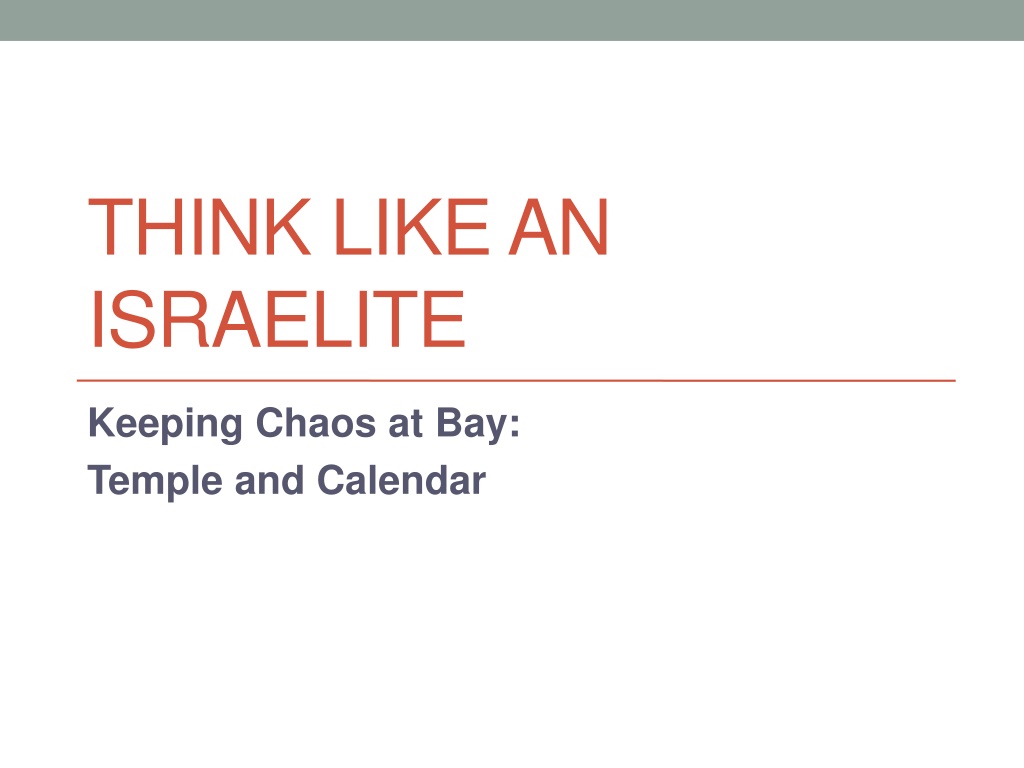
Exploring the Concept of Chaos and Order in Ancient Israeli Mythology
Delve into the symbolic metaphors and mythical narratives prevalent in ancient Israeli culture, particularly focusing on the concepts of chaos and order as depicted in biblical stories. Understand the significance of sacred space, the battle against chaos represented by sea monsters and serpents, and the triumph of divine order over chaotic forces. Explore passages from Psalms illustrating the divine control over the seas and the establishment of earthly boundaries.
Download Presentation

Please find below an Image/Link to download the presentation.
The content on the website is provided AS IS for your information and personal use only. It may not be sold, licensed, or shared on other websites without obtaining consent from the author. Download presentation by click this link. If you encounter any issues during the download, it is possible that the publisher has removed the file from their server.
E N D
Presentation Transcript
THINK LIKE AN ISRAELITE Keeping Chaos at Bay: Temple and Calendar
Intellectual Adjustment MythicThinking Does not mean biblical stories are fairy tales Refers to symbolic metaphors used to make concepts comprehensible Bible has many of them visual metaphors that do not conform to a scientific world that help us grasp theological concepts. sacred space was one of them
In Other Words Sacred Space is: Where God is, or has appeared Set off from normal ( mundane ) space New Elements: Where God is, there is peace, order, and justice (shalom); absence of chaos. Every place that lacks the above must be made fit for divine presence.
Chaos Describes the state of disorder that would exist in the absence of a divinely imposed order on the cosmos. In biblical and ancient Near Eastern literature, the supreme gods brought order to the universe and subdued the forces of chaos. The chaotic unpredictability and latent threat of the sea ( , yam) resulted in its coming to represent these forces of chaos in ancient literature such as the Baal Cycle, where one of
Chaos Baal s main conflicts is a battle against the god of the sea, Yamm (the same Semitic word as the Hebrew for sea, yam). Baal s eventual victory symbolizes the triumph of order over chaos. In addition to the sea itself, chaos could be represented as a great sea serpent or dragon ( , tnyn), variously known as Leviathan, Rahab, or Tiamat.
Psa 74:12-17 12Yet God my King is from of old, working salvation in the midst of the earth. 13You divided the sea (yam) by your might; you broke the heads of the sea monsters (tnynym) on the waters. 14You crushed the heads of Leviathan; you gave him as food for the creatures of the wilderness. 15You split open springs and brooks; you dried up ever-flowing streams. 16Yours is the day, yours also the night; you have established the heavenly lights and the sun. 17You have fixed all the boundaries of the earth; you have made summer and winter.
Psa 89:8-11 8O Lord God of hosts, who is mighty as you are, O Lord, with your faithfulness all around you? 9You rule the raging of the sea (yam); when its waves rise, you still them. 10You crushed Rahab like a carcass; you scattered your enemies with your mighty arm. 11The heavens are yours; the earth also is yours; the world and all that is in it, you have founded them.
Isa 51:9-10 9Awake, awake, put on strength, O arm of the Lord; awake, as in days of old, the generations of long ago. Was it not you who cut Rahab in pieces, who pierced the dragon (tnyn)? 10Was it not you who dried up the sea (yam), the waters of the great deep (tehom),who made the depths of the sea (yam) a way for the redeemed to pass over?
Genesis 1-2 1In the beginning, God created the heavens and the earth. 2The earth was without form and void, and darkness was over the face of the deep (tehom). And the Spirit of God was hovering over the face of the waters. 31And God saw everything that he had made, and behold, it was very good (t o b me o d). And there was evening and there was morning, the sixth day.
Genesis 1-2 Gen 1:31 does not mean the earth was perfect (ta m m)
All the Earth was not Eden Eden is the first sacred space (no chaos) God made Eden his sole residence Eden had geography (Gen 2:5-14) Invited humans there (original intention was humanity was part of the family) The rest of earth = God wanting human participation in bringing earth into submission (Gen 1:28) You don t need to subdue and have dominion over something in a perfect / completed state.
The Fall Irruption of chaos Eden is no more Sacred space from that point forward had to be chosen by God and then kept chaos free by ritual act or ritually prepared for divine presence.
Holding Chaos at Bay Main metaphor for restoration and maintenance of order (even extending to the cosmos) = the temple (Earlier session): Ezek 38:12 (Jerusalem = center of the earth) Cosmic center of Jerusalem = temple
Holding Chaos at Bay Meyers, ABD: Just as spectacular as its size was its ornamentation. Under its rim was a series of cast decorations: two rows of gourds. The rim ( brim ) itself was made of lily work. Most amazing of all was the way it was supported on four sets of bronze oxen, with three oxen in each set. Each set of oxen faced a direction of the compass, with their hinder parts facing inward and supporting the basin.
Holding Chaos at Bay The directional orientation led Albright to suppose (a la Ezekiel 1's cherubim faces) that the oxen = 12 elements of zodiac / cardinal points, signifying the temple as the center of the universe as it were.
Holding Chaos at Bay The bronze sea had a very large quantity of water much more than merely for hand- washing by priests ( 3000 baths ) = 66,000 liters (= 17,435 gallons) = 27-foot diameter round pool / 4-feet high. Recall that this item was NOT present in tabernacle
Holding Chaos at Bay Meyers, ABD (cont.): "One of the features of ANE temples was their utilization of artistic and architectural elements relating to the idea of the temple as the cosmic center of the world. The great deep, or cosmic waters, is one aspect of the array of cosmic attributes of such a holy spot. The temple of Marduk at Babylon, for example, had an artificial sea (ta-am-tu) in its precincts; and some Babylonian temples had an aps - sea, a large basin. ..
Holding Chaos at Bay Meyers, ABD (cont.): . . . Such features symbolize the idea of the ordering of the universe by the conquest of chaos; or they represent the presence of the waters of life at the holy center. Ancient Israel shared in this notion of watery chaos being subdued by Yahweh and of the temple being built on the cosmic waters. The great molten sea near the temple s entrance would have signified Yahweh s power and presence."
Holding Chaos at Bay Take note of Ezek 43:15 15 and the altar hearth (har e l) , four cubits; and from the altar hearth (h ari e l) projecting upward, four horns. Cf. Isa 29:1ff for alternate spelling har e l related to Sumerian arallu
Holding Chaos at Bay Levenson [The term har'el] in the same passage (verse 15) is to be connected with Akkadian arallu, a term for the netherworld, about which the Chicago Assyrian Dictionary remarks that it was interalia, a "cosmic locality opposite of heaven," although we should note, as does Albright, that the ancient Israelites may have understood this term as "mountain of God" (har'el), which is a concept no less cosmic. Levenson, Theology of the Program of Restoration of Ezekiel 40-48
Holding Chaos at Bay Calendar Considerations (Qumran sect) Merkabah vision (Ezekiel 1) throne-chariot of God, a concept linked to the temple itself.
Holding Chaos at Bay (Elior, The Three Temples, 29) In the Holy of Holies (devir) of Solomon s Temple, two gold-plated cherubim shielded the cover of the Ark with their wings (1 Kings 6:23-35; 8:6-7); their appearance, revealed to David as a divine pattern, is described in the parallel passage in Chronicles, which explicitly links the cherubim with the heavenly Chariot Throne: for the pattern of the chariot the cherubim those with outspread wings screening the Ark of the Covenant of the Lord (1 Chron 28:18).
Holding Chaos at Bay (Elior, p. 30) The Merkavah was thus a representation of the ritual order of cyclic ritual time, measured in sabbaths of days, i.e., weeks. But the fourfold annual seasons in turn subdivided in accordance with a fixed sevenfold order; similarly, the concept of sacred time derived from the seven days of Creation; accordingly, there are seven days in a week, counted in sabbaths of days ; seven days of service performed by each priestly course serving in the temple; seven days of consecration (miluim; see Lev 8:33); and seven-week intervals between harvesting times.
Holding Chaos at Bay Qumran priests believe in this calendar: Began on Day 4 of creation If used, all numerically significant events (sabbaths, Passover, feasts, jubilee, Day of Atonement, etc.) falls on the same day every day Perfect mathematical symmetry Believed this calendar reflected and derived from the mind of God.
Holding Chaos at Bay Consequently, this calendar had to be observed by priesthood to keep heaven and earth in sync. Otherwise, chaos in God s land, the whole world (Beckwith): Calendar produced a date for messiah s appearance sometime between 3 BC- 2 AD ( an end to sin i.e., an end to period of wickedness and end of exile); revolves around their understanding of the 70 weeks = 10 jubilee cycles.
Holding Chaos at Bay Birth of Jesus predicted / falls into Qumran jubilee system (sign to that sect). If you use the calendar followed by the Pharisees (lunar + added month periodically), the birth date wasn t a Jubilee year. But by biblical chronology, the year Jesus began his ministry was a jubilee year: Luke 4:14-19
Holding Chaos at Bay Their emphasis on jubilee cycles noteworthy for idealized temple of Ezek 40-48. Scholars have noted the numbers and dimensions of the temple are consistently multiples of 25 (half a jubilee) and fifty (a jubilee). # 25 = 8x in chs 40-48 # 50 = 10x in chs 40-48 #100 = 13x in chs 40-48 #250 = 4x ... #500 = 8x ... (walls) #1,000 = 4x #5,000 = 2x #10,000 = 7x #25,000 = 14x (land allotments) NT Temple talk? = 60 references to jubilee numbers and their multiples


